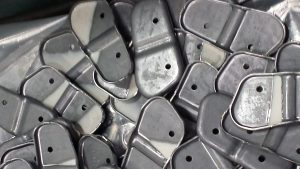 Very often, too much weight in stamping lubricant selection is placed on cost per gallon. While definitely a serious consideration, what one may be saving “up front” in cents and dollars per gallon can quickly multiply costs in other production areas many fold. There are several factors that directly affect the cost of a stamping lubricant that should be carefully weighed—along with thorough in-process testing prior to implementation:
Very often, too much weight in stamping lubricant selection is placed on cost per gallon. While definitely a serious consideration, what one may be saving “up front” in cents and dollars per gallon can quickly multiply costs in other production areas many fold. There are several factors that directly affect the cost of a stamping lubricant that should be carefully weighed—along with thorough in-process testing prior to implementation:
• Newer chemical technologies and water-based additives can often cost more “up front” as producing these ingredients is typically more complicated and expensive than older chemical technologies. While appearing initially more expensive per gallon—these water-based chemistries often run more cleanly and cooler than many oil-based products.
• How concentrated a stamping fluid is can greatly affect its “up front” cost. In the grand scheme of things—base oils and water tend to be the more inexpensive ingredients in stamping fluids. More specialized additives that impart corrosion protection, lubricity, EP/AW and buffering of the stamping fluid are generally the more expensive components. If you have a more heavily fortified product—you will likely see a higher price associated. Typically, less fortified products will require much higher concentrations and/or higher volumes of application to provide adequate protection to parts and tooling.
• Different products may “wet-out” on parts differently—this can effect how the lubricant is transferred through dies from stage to stage. Additionally; a product used at 9:1 (10%) may run-off of a part/dies quickly while the same lubricant used at 5:1 (16.7%) may cling better to the same part/dies—potentially yielding better part finish, tool life and corrosion protection.
• Flooding lubricant onto dies and parts leads to higher overall chemical consumption—even at dramatically lower solution concentrations. Excess fluid winds up on shop floors, carried out on parts into hoppers and into subsequent stages like welding and pretreatment. Excessive lubricant volume is associated with increased costs in all these other production areas. For these reasons IRMCO always recommends minimal volume of the optimized fluid concentration be utilized in stamping processes.


